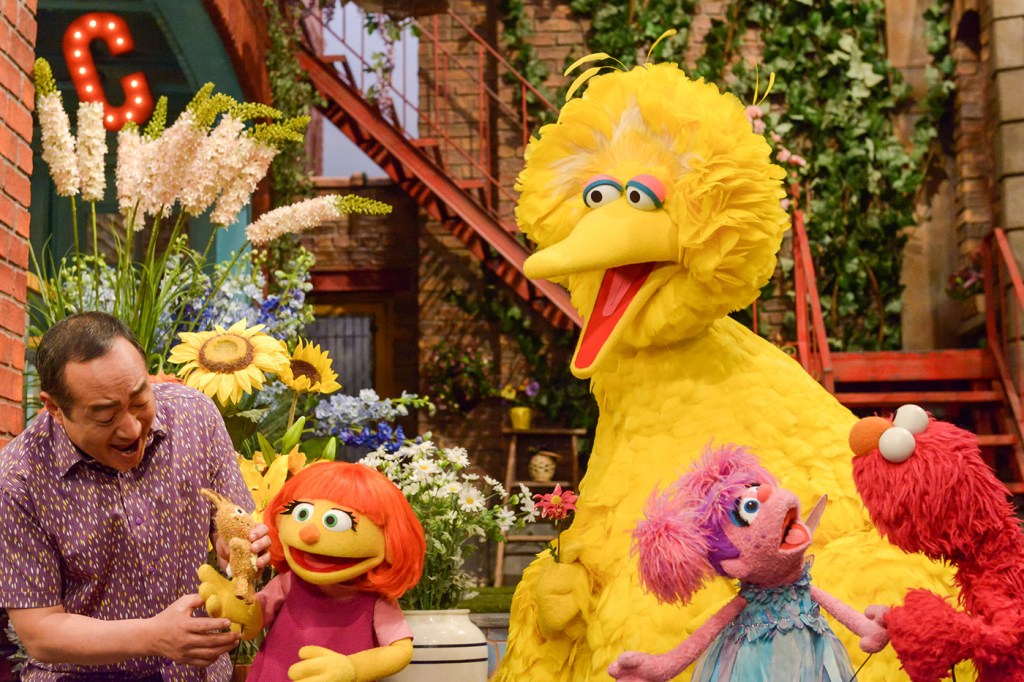How new research and Sesame Street are expanding our understanding of autism

She has bright orange hair, loves to sing, and is excellent at memorizing song lyrics. She can take longer than others to respond to questions, and is sensitive to loud noises, including sirens.
Meet 4-year-old Julia, the first new Muppet that Sesame Street has introduced on the air in a decade. It’s fitting the PBS show will bring her to Muppet life on April 10, in the midst of National Autism Awareness Month and just days after World Autism Awareness Day, on April 2, as Julia has autism. “So she does things a little differently,” says Elmo in the Sesame Street digital storybook We’re Amazing 1, 2, 3!, a part of the show’s campaign See Amazing in All Children, which launched in 2015. On Friday, the Northeastern chapter of Sigma Sigma Sigma, along with the nonprofit Best Buddies, hosts its observance of Autism Awareness Day at Curry Crossroads from 10 a.m. to 4 p.m.
Currently, about 1 in 68 American children has been diagnosed with autism spectrum disorder, according to the latest surveillance report from the Centers for Disease Control and Prevention, an increase of some 119 percent since 2000. The theme of this year’s World Autism Awareness Day is “Toward Autonomy and Self-Determination.” With that in mind, we asked Northeastern experts in the field to discuss some of the technologies being developed to help increase autonomy among people with autism.
Meryl Alper, assistant professor in the Department of Communication Studies in the College of Arts, Media and Design
In your book Giving Voice: Mobile Communication, Disability, and Inequality, you investigate the social implications of communication technologies for individuals with disabilities. How can such systems support independence, and what are some of the factors that impede their ability to do so?
Research has shown that up to 25 percent of children on the autism spectrum have significant difficulties with spoken language. Autistic individuals who are unable to communicate independently and spontaneously may sometimes resort to challenging behaviors to express their needs and convey their feelings. Communication supports that augment or provide an alternative to oral speech can reduce their frustration and give them a reliable means of interacting with others. There are many types of augmentative and alternative communication (AAC) strategies, including nonverbal gestures and picture symbol cards. Over the past 10 years, high-tech AAC systems have increasingly taken the form of smartphones, tablet computers, and apps. Like any technology, though, their benefits are not inevitable. For instance, the cost, though much lower than traditional high-tech AAC systems, is still prohibitive for many families. Health insurance may not cover it, or require extensive documentation from medical professionals, which can be cost and labor intensive. Even once the technology is obtained, none of the children’s teachers might encourage them to use it in class, even if they are legally bound to do so. The child’s AAC system might be in English, while a different language is spoken at home. Essentially, technological interventions to include autistic people in society rarely account for all these other ways in which culture, law, policy, and even technology itself can marginalize and exclude.
For years you worked in children’s media, including Sesame Workshop in New York and Nick Jr. in Los Angeles. How might the integration of Julia into Sesame Street raise awareness not just about autism but also about the role of technologies in addressing certain inequities prevalent in society?
In the clips that I have seen of Julia, she primarily communicates with oral speech and does not use AAC. However, when autistic children are distressed and having a meltdown (perhaps due to an environment that is overstimulating), they may find it easier to gesture or point to a picture than to use spoken language. The show might incorporate AAC in this manner with Julia. But there are already a number of videos on the See Amazing in All Children website that feature real-life autistic children who use AAC devices, such as “Thomas’s Story” and “What Makes You Amazing.” I think then that it’s less important for Julia to singlehandedly address all issues that arise in the lives of autistic children, and more important that she’s not the last character who is openly autistic on children’s television. Having worked with the research team that brought Julia to the screen, I know that Sesame Workshop was in a unique position to handle this responsibility. It would be a shame, though, to stop short of representing more of the autistic experience, such as that of black and Latinx autistic youth.
Matthew Goodwin, assistant professor with joint appointments in the Bouvé College of Health Sciences and the College of Computer and Information Sciences
You use sophisticated algorithms to analyze data collected from wearable sensors, ceiling cameras, and microphones to track internal states such as pulse rate, temperature, skin conductance, and repetitive behaviors of people with autism. What can such automated monitoring tell you about the participants that other strategies, such as observation, can’t?
Observing can only tell us so much. A child who looks calm may in fact be essentially frozen with anxiety, or one who is flapping his hands, a common repetitive behavior among people with autism, may be soothing himself or, conversely, expressing frustration. Observation shows behaviors but not what is driving those behaviors. Indeed, two people watching the same behavior, for example, repetitive rocking, are likely to interpret the cause of the behavior differently. Many people with autism have difficulty communicating, which means surveys are often conducted with parents or teachers. That, too, makes the interpretation of the behaviors potentially subjective.
How can automated monitoring lead to helping people with autism take greater control of their own health?
Cameras, microphones, and sensors can help caregivers understand the environmental situations and stimuli that cause distress, even when the person they are helping can’t verbalize the source. That understanding enables them to respond more appropriately and/or recruit the social supports that can help regulate the behavior. For example, if a child who appears calm has a racing pulse rate, suggesting guided prompts to engage in relaxed, paced breathing or progressive muscle relaxation would be more helpful in alleviating the stress than attempting to engage her in an activity. The ultimate goal is to help individuals with autism themselves learn what stresses and relaxes them so they can increase self-awareness and engage in self-regulation, reducing reliance on caregivers.
Amy Lu, assistant professor with joint appointments in the Department of Communication Studies in the College of Arts, Media and Design and the Bouvé College of Health Sciences
You research the power of stories to change children’s views, attitudes, and behaviors and the psychological mechanisms that determine how those stories engender those changes. What is it about animated characters, puppets, and costumed people that attracts children with autism, and how might such narratives help them?
From my perspective, when compared to live-action media characters, animated characters, puppets, and costumed people in general have a more simplified rendering of facial expression, more distinctive style of outfits, more exaggerated type of movements, and more theatrical quality of performance. In other words, all of the characters’ features have been further stylized. Since several aspects of face processing are impaired by autism, the stylized features would make the characters much easier for children with autism to process and appreciate (for example, recognize a character just by the color of the hair or outfit). As a result, these features would serve as effective scaffolding for them to better understand stories, in which characters are a crucial component.
What characteristics of Julia on Sesame Street might bring about greater understanding of autism for everyone?
A good story has the ability to suspend disbelief, increase attention, and provide characters to identify with and thus motivate children to learn and even change their behaviors. With good character and narrative design, children with and without autism should have an equal opportunity to be involved in the story. While I only watched a few of the Julia-related Sesame Street clips, I liked what I saw. In one instance, Elmo and friends were trying to help the viewers understand that children with autism may not be as “impolite” as they might have thought them to be and that they could still be friends, acknowledging the difference.
Seeing Julia on their favorite show may help children without autism acknowledge the existence of such a developmental condition. Seeing how other characters in the narrative interact with Julia may teach children social norms when interacting with a child with autism in real life. The introduction of Julia would also afford a good opportunity for children with autism to see themselves in the show, potentially enhancing their attention and even easing their social anxieties.





